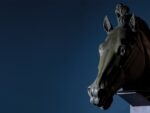Renato D’Agostin – Etna
.jpg)
Nuovo progetto fotografico di Renato D’Agostin (Venezia, 1983), che ormai da molti anni vive e lavora a NYC, dove è stato assistente di uno dei più grandi maestri della fotografia del XX secolo, Ralph Gibson.
Comunicato stampa
Ha visitato l'Etna nel 2012. «Ho trascorso ore camminando intorno a questo incredibile deserto nero» dice Renato D’Agostin. «Diversamente da come sono abituato a muovermi in un contesto urbano, solitamente pronto a comprimere e gestire più livelli, sull'Etna, invece, ho lavorato sulla distanza e sull'estensione. La materia e la struttura hanno caratterizzato fortemente l'esperienza visiva poiché il fumo e le nuvole avvolgevano i turisti che passeggiavano e si spostavano qua e là, come esploratori di un pianeta remoto».
ETNA è il nuovo progetto fotografico di Renato D’Agostin (Venezia, 1983), che ormai da molti anni vive e lavora a NYC, dove è stato assistente di uno dei più grandi maestri della fotografia del XX secolo, Ralph Gibson.
Lo sguardo di D’Agostin, raffinato interprete di linee e forme ed esperto cacciatore di luci e ombre, trasforma le immense vallate del vulcano siciliano in uno scenario alieno, desolato, lunare, sul quale si stagliano indefinite figure e pallide ombre, evanescenti tra fumi e nebbie dal sapore dantesco. Presenze smarrite in un paesaggio impietoso che attraggono il nostro sguardo, sembrano muoversi lungo sentieri definiti come percorsi ineluttabili, nell’atto di compiere un trasognato cammino attraverso il mondo sospeso e incantato del vulcano, animato nel profondo della sua quiete irreale da infiniti richiami simbolici e sotto la cui coltre di nera lava cela mai sopita la sua indomita potenza. Un coro, inciso nel nero vinile del 45 giri che accompagna il libro, recita a 4, 6 e 8 voci i versi composti per l’occasione dal poeta padovano Luigi Cerantola, secondo una partitura che ricorda un canto antico e rituale, in cui riecheggiano il ribollire del magma e il brontolio viscerale pronto ad esplodere. Il potenziale di energia e forza si nasconde in quei neri profondi che squarciano bianchi del cielo o dei fumi, grazie alla maestria con cui D’Agostin stampa in camera oscura, rigorosamente da pellicola. Rende così l’atmosfera carica di una sottesa tensione: un’apnea che sembra dover esplodere da un momento all’altro. Un contrasto voluto e cercato, specchio dell’Anima che ha luci e ombre. Le stesse che trovarono sfogo nella danza Butoh. Un Yin e Yang che lo lega direttamente, in modo quasi ombelicale, al lavoro di uno dei suoi maestri ideali, Eikoh Hosoe.
Claudio Composti
He visited Mount Etna in 2012. “I spent hours walking around this incredible black desert,” he says. “Differently from how I shoot in a city context, where I compress layers, on the Etna I worked on distance and extension. Matter and texture became a strong part of the visual experience, with smoke and clouds wrapping up tourists that were walking around or moving around the surface in little vans, like explorers of a remote planet”.
ETNA is the last project by Renato D’Agostin (Venice, 1983). For several years now, he lives and works in NYC, where he has been assistant to Ralph Gibson, one of the greatest photographer of the XX century.
D’Agostin pursues his visual research focusing on sophisticated relations between lines and shapes and between lights and shadows. Through his eye, the wide valleys of the Sicilian volcano turn into an alien, desolate, lunar landscape, rarely studded with unclear figures and pale shadows almost fading among the smokes and fogs recalling Dante’s Inferno. Like lost presences in such an unmerciful land, they catch our eyes while seemingly moving forward along undefined tracks, as if forced to follow their inescapable path. They move their journey through the volcano’s suspended atmosphere, enlivened by symbolic echoes deep down its unreal quiet and disguising its untamed, never unleashed power under the black lavic flow. Engraved into the black vinyl of the EP coming with the catalogue, a chorus for 4, 6 and 8 voices recites the Paduan poet Luigi Cerantola’s lines expressly composed to sound like an ancient, ritual hymn evoking the boiling magma and the visceral rumble ready to explode. Thanks to D’Agostin’s expertise in darkroom development, the load of power and intensity appears to be hiding behind those black spots piercing the white surfaces of the sky and the smokes, conveying the feeling of an atmosphere full of underlying tension, as an apnoea which might suddenly burst. The photographer’s pursuit of contrast between light and dark purposely provides a mirror of the Soul, of its lights and shadows: the same elements unleashed in Butoh dance and a sort of Ying and Yang reflection which links him straight, in an almost umbilical way, to Eikoh Hosoe, main inspirational source for Renato D’Agostin’s photography.
Claudio Composti



